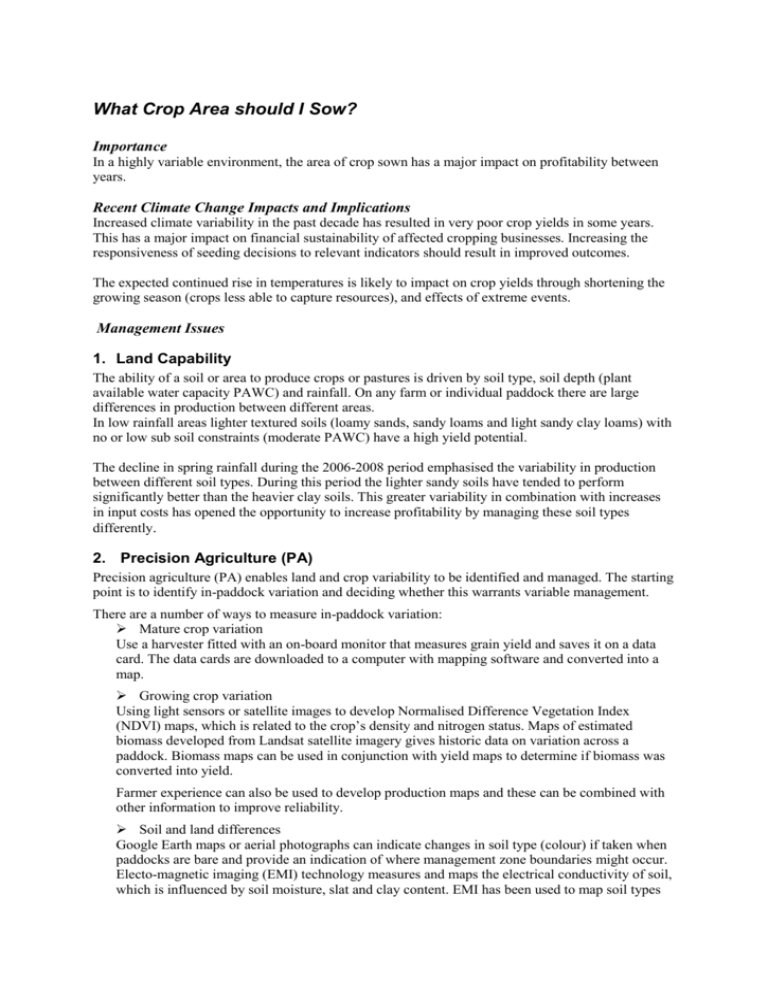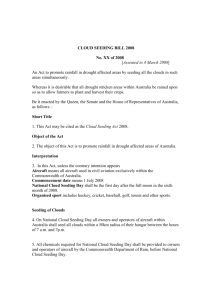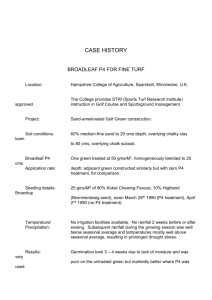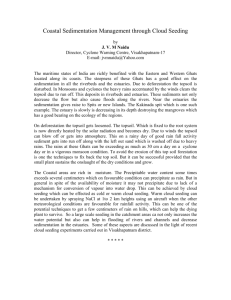What Crop Area should I Sow? Importance In a highly variable
advertisement

What Crop Area should I Sow? Importance In a highly variable environment, the area of crop sown has a major impact on profitability between years. Recent Climate Change Impacts and Implications Increased climate variability in the past decade has resulted in very poor crop yields in some years. This has a major impact on financial sustainability of affected cropping businesses. Increasing the responsiveness of seeding decisions to relevant indicators should result in improved outcomes. The expected continued rise in temperatures is likely to impact on crop yields through shortening the growing season (crops less able to capture resources), and effects of extreme events. Management Issues 1. Land Capability The ability of a soil or area to produce crops or pastures is driven by soil type, soil depth (plant available water capacity PAWC) and rainfall. On any farm or individual paddock there are large differences in production between different areas. In low rainfall areas lighter textured soils (loamy sands, sandy loams and light sandy clay loams) with no or low sub soil constraints (moderate PAWC) have a high yield potential. The decline in spring rainfall during the 2006-2008 period emphasised the variability in production between different soil types. During this period the lighter sandy soils have tended to perform significantly better than the heavier clay soils. This greater variability in combination with increases in input costs has opened the opportunity to increase profitability by managing these soil types differently. 2. Precision Agriculture (PA) Precision agriculture (PA) enables land and crop variability to be identified and managed. The starting point is to identify in-paddock variation and deciding whether this warrants variable management. There are a number of ways to measure in-paddock variation: Mature crop variation Use a harvester fitted with an on-board monitor that measures grain yield and saves it on a data card. The data cards are downloaded to a computer with mapping software and converted into a map. Growing crop variation Using light sensors or satellite images to develop Normalised Difference Vegetation Index (NDVI) maps, which is related to the crop’s density and nitrogen status. Maps of estimated biomass developed from Landsat satellite imagery gives historic data on variation across a paddock. Biomass maps can be used in conjunction with yield maps to determine if biomass was converted into yield. Farmer experience can also be used to develop production maps and these can be combined with other information to improve reliability. Soil and land differences Google Earth maps or aerial photographs can indicate changes in soil type (colour) if taken when paddocks are bare and provide an indication of where management zone boundaries might occur. Electo-magnetic imaging (EMI) technology measures and maps the electrical conductivity of soil, which is influenced by soil moisture, slat and clay content. EMI has been used to map soil types and to detect zones with different subsoil constraints and crop yield potential. These maps need to be ground-truthed by soil sampling and analysis. Gamma radiometric surveys indicate the variation in surface soil texture – sand through to clays. Developing Production Zones If there is sufficient variation in yield or production to justify changing the inputs to certain areas, management zones can be created. These zones are areas of the paddock, which will be managed in a particular way. Simple management zones can be created based on knowledge of soil type and productivity. More detailed and accurate zones are produced using software packages that can combine different layers of data. Benchmarks Table 2 Annual benefit of adopting Precision Agriculture technologies (SA growers) Annual benefit ($/ha) Savings in overlap $6 Fertiliser management $8 Increased production using VRT $7 Inter-row sowing/reduced soil compaction/ shielded spraying $13 Tools Grain Yield maps NDVI maps EMI maps Google Earth maps Nature Maps Mapping software 3. Soil Bucket Size The bucket size or plant available water capacity (PAWC) of a soil will vary depending on soil texture and rooting depth. The rooting depth can often be restricted by subsoil constraints, such as sheet rock, hard pans, salinity, boron, or sodicity. Physical soil tests taken to a depth of 80 to 100 cm (where possible) in different management zones will help determine PAWC. The autumn rainfall decline over the last decade has reduced the capacity of soils with high clay content and plant available water capacity to store water during the autumn and winter period for use by the crop in spring. In seasons with extended dry periods crops on these soils have become severely moisture stressed, due to their high wilting point. Indicators Table 3 Plant available water capacity (PAWC mm) of different soil types and rooting depths Rooting Depth Sand Clayey sand Sandy loam Clay loam 28 35 48 40 cm 72 42 52 72 60 cm 108 56 70 96 80 cm 144 70 86 120 100 cm 120 cm 84 102 Table 4: Potential Yield of wheat on a range of soils with different plant available water capacity and growing season rainfalls. PAWC Growing Soil Type Season Sand Clayey Sand Sandy loam Clay loam Rainfall 190 1.19 1.16 1.01 40 mm 0.53 226 1.57 1.55 1.42 0.88 262 1.93 1.90 1.79 1.26 190 1.36 1.33 1.16 60 mm 0.64 226 1.86 1.84 1.68 1.07 262 2.34 2.32 2.17 1.54 190 1.48 1.46 1.26 80 mm 0.69 226 2.07 2.05 1.86 1.2 262 2.62 2.60 2.44 1.75 190 120 mm 0.71 226 1.3 262 2.02 Data derived from APSIM In the low rainfall areas the heavier soils (clay loams to clays) struggle to provide sufficient moisture to produce a profitable grain yield. When these heavier soils have sub soil constraints, which limits rooting depth and PAWC these soils can become unviable for cropping in all but above average seasons. Trigger Points Table 5: Sowing Decisions with a late Break (after end May) Yield Potential of Suggested Action Soil type / Paddock Always sow High Don’t sow after mid July Medium Don’t sow after late June Low Tools Soil analysis Soil texture APSIM 4. PAW and Seeding Opportunity It has been long recognised that: Early seeding generally provides the most reliable and best yield outcome Frost prone areas have special considerations which need to be taken into account The higher the PAW at seeding, the more reliable the yield outcome. On responsive soil types, the interaction between Plant Available Water and seeding opportunity can provide a clear predictor on the likelihood of successful crop output. Simulated historic wheat yields have been modelled for different locations in the Upper North of SA. These have then been analysed to assess the impact of PAW at seeding and seeding opportunity on the variability of resultant crop yields. Examples are presented for Port Germein, Orroroo and Appila. a) Port Germein The effects of different ranges of PAW and seeding opportunity on the probability of different yield outcomes are shown in Figure 1. Seeding opportunities were divided into terciles with: (i) Early- 15th April to 3rd May; (ii) Middle- 4th May to 2nd June and ; (iii) Late- 2nd June onwards. Modelled data indicates that the interaction of plant available water at seeding and seeding opportunity is a strong indicator of final crop yields. The combination of low PAW and late seeding rarely produces a favourable outcome with most yields in the lower tercile. At the other extreme, poor crop yields (in the lowest tercile) are rare when PAW at seeding is categorised as high. a) Low Modelled Plant Available Water (< 17 mm) at seeding Early Seeding Opportunity Middle Seeding Opportunity Late Seeding Opportunity b) Moderate Modelled Plant Available Water (17 to 40 mm) at seeding Early Seeding Opportunity Middle Seeding Opportunity Late Seeding Opportunity c) High Modelled Plant Available Water (> 40 mm) at seeding Early Seeding Opportunity Middle Seeding Opportunity Late Seeding Opportunity Figure 1: Effect of variations in PAW and seeding opportunity on percentage of modelled yields in upper tercile (white), middle tercile (grey) and lower tercile (black). b) Orroroo a) Low Modelled Plant Available Water (? mm) at seeding b) Moderate Modelled Plant Available Water (? mm) at seeding c) High Modelled Plant Available Water (> ? mm) at seeding Plant Available Water at Sowing Low Medium High Early Before 15th May Time of Sowing Mid 15th May to 25th June Late After 25th June Figure 2: Effect of variations in PAW and seeding opportunity on percentage of modelled yields in upper tercile (blue), middle tercile (yellow) and lower tercile (red) When high PAW good confidence in getting above average yields. Medium PAW still reasonable confidence but low PAW much more variable. c) Appila a) Low Modelled Plant Available Water (< 31 mm) at seeding b) Moderate Modelled Plant Available Water (31 to 47 mm) at seeding c) High Modelled Plant Available Water (> 47 mm) at seeding Plant Available Water at Sowing Low < 31 mm Early Before 5th May Time of Sowing Mid 5th May to 10th June Late After 10th June Medium 31– 47mm High > 47 mm Figure 4: Effect of variations in PAW and seeding opportunity on percentage of modelled yields in upper tercile (blue), middle tercile (green) and lower tercile (red) d) Quorn a) Low Modelled Plant Available Water (< 0 mm) at seeding b) Moderate Modelled Plant Available Water (0 to 15 mm) at seeding c) High Modelled Plant Available Water (> 15 mm) at seeding Greater Flexibility gives greater Profitability These pie charts can be used to develop “Rules of Thumb” to enable producers to respond to opportunities and reduce risk, depending on the probability of different yield outcomes. For example: Three farm programs can be developed and the program implemented, in any one year will depend on plant available water at sowing and timing of opening rains (sowing opportunity). 1. Conservative – reduce fertiliser application, particularly on the poorer producing soils Reduce crop area on poorer soils Remove high risk crops from the rotation (field peas, canola etc) 2. Standard – sow average crop area with normal input levels 3. Optimistic – increase area of crop, including higher risk crops (field peas and oaten hay) Increase inputs, particularly N & P fertiliser Note: Livestock numbers remained the same, although feeding costs increased in poor seasons. Rules of Thumb Season / Soil Moisture Early sowing Low PAW Early sowing Medium PAW Early sowing High PAW Mid sowing Low PAW Mid sowing Medium PAW Mid sowing High PAW Late sowing Low PAW Late sowing Medium PAW Late sowing High PAW Farm Plan Implemented Standard Optimistic Optimistic Standard Standard Optimistic Conservative Conservative Optimistic Using this approach on a farm in the Orroroo district over a 26 year period (1985 to 2010) resulted in 6 conservative plans (23%), 12 standard plans (46%) and 8 optimistic plans (31%). Annual profit was calculated using actual yields and average prices and costs. Using this flexible system gave an average annual increased profit of $14,000 compared to the standard system. In two years profitability was lower (1 conservative and 1 optimistic plan) than using the standard system, 12 years the same (standard system was used) and in 12 years profitability was greater. Developed with funding from DEWNR




